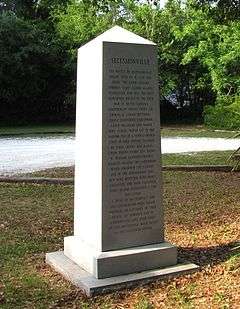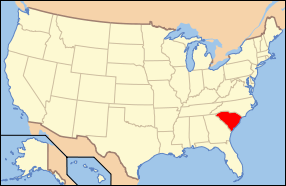Secessionville Historic District
|
Secessionville Historic District | |
|
Obelisk at the Fort Lamar site, Secessionville Historic District, May 2010 | |
  | |
| Location | North of Folly Beach, near Folly Beach, South Carolina |
|---|---|
| Coordinates | 32°42′18″N 79°56′35″W / 32.70500°N 79.94306°WCoordinates: 32°42′18″N 79°56′35″W / 32.70500°N 79.94306°W |
| Area | 41 acres (17 ha) |
| Built | 1862 |
| Architectural style | Late Victorian, Greek Revival |
| NRHP Reference # | 79002378[1] |
| Added to NRHP | October 1, 1979 |
Secessionville Historic District is a national historic district located near Folly Beach, Charleston County, South Carolina. It extends into the city of Charleston, South Carolina. The district encompasses six contributing buildings, one contributing site, and one contributing site in Secessionville. The district includes the summer homes of several leading James Island planters, the site of the American Civil War Battle of Secessionville, the unmarked grave of over 300 Union soldiers, and the remains of Fort Lamar, constructed about 1862.
The houses include one Victorian and two antebellum Greek Revival residences.[2][3]
It was listed on the National Register of Historic Places in 1979.[1]
References
- 1 2 National Park Service (2010-07-09). "National Register Information System". National Register of Historic Places. National Park Service.
- ↑ Elias B. Bull and Julie Burr (April 1978). "Secessionville Historic District" (pdf). National Register of Historic Places - Nomination and Inventory. Retrieved 2014-08-01.
- ↑ "Secessionville Historic District, Charleston County (Secessionville, James Island)". National Register Properties in South Carolina. South Carolina Department of Archives and History. Retrieved 2014-08-01. and accompanying map.
This article is issued from Wikipedia - version of the 11/30/2016. The text is available under the Creative Commons Attribution/Share Alike but additional terms may apply for the media files.


